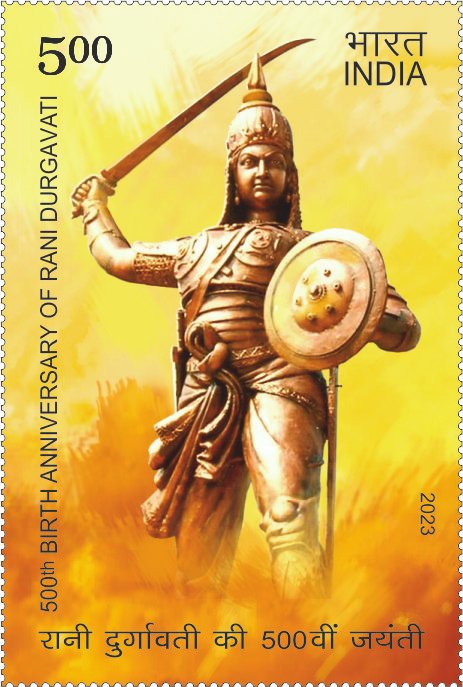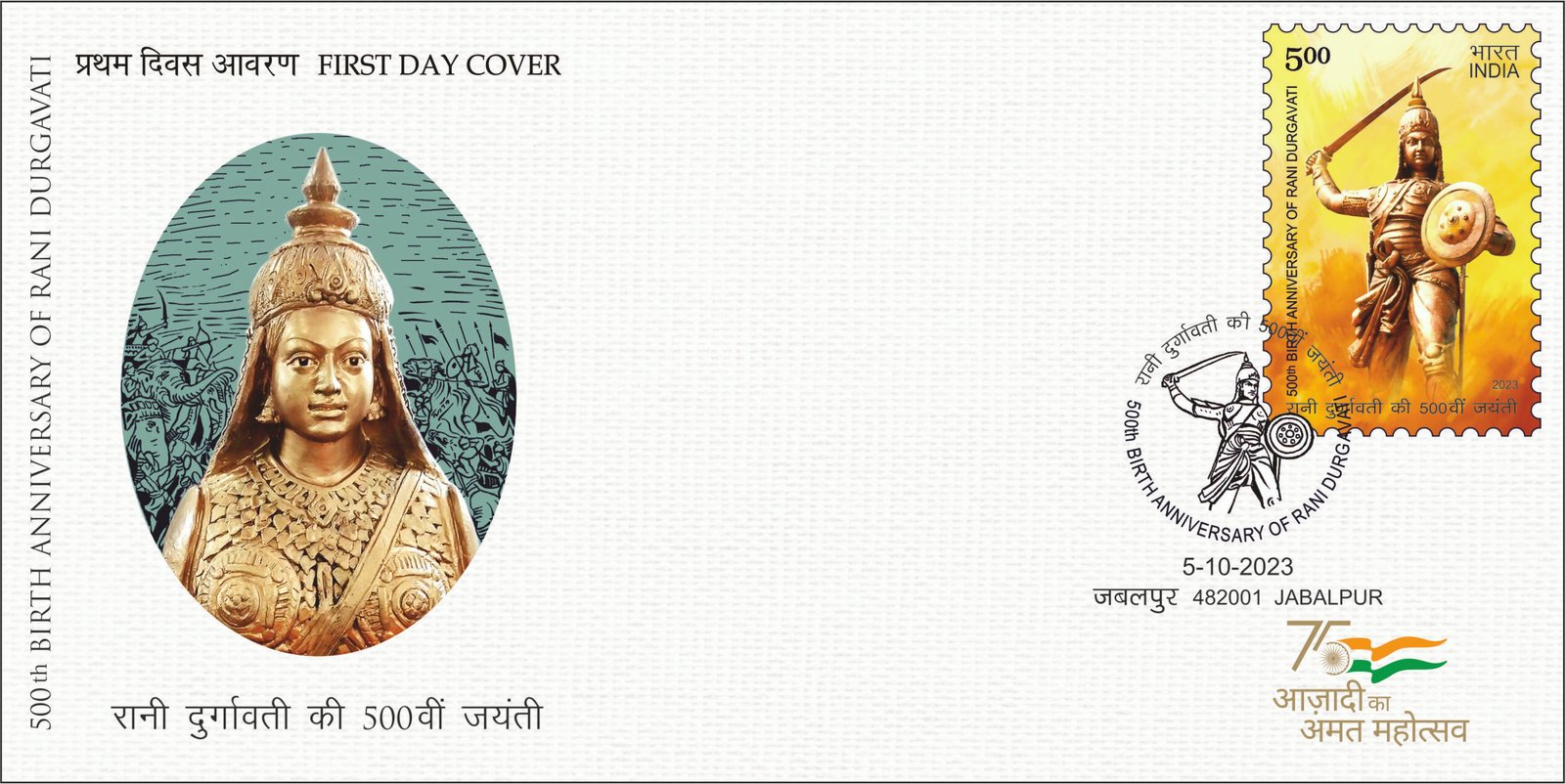500th Birth Anniversary of Rani Durgavati

Technical Data
| Date of Issue | October 5, 2023 |
|---|---|
| Denomination | Rs. 5 |
| Quantity | 201,600 |
| Perforation | 13½ |
| Printer | Security Printing Press, Hyderabad |
| Printing Process | Wet Offset |
| Watermark | No Watermark |
| Colors | Multicolor |
| Credit (Designed By) | Sh. Sankha Samanta |
| Catalog Codes |
Yvert et Tellier IN 3593 Colnect codes IN IN 2023.10.06-01 Michel IN 3936 Stanley Gibbons IN 3864 |
| Themes | Anniversaries and Jubilees | Famous people | Queens | Statues | Women |
Rani Durgavati, the descendant of the famous Chandela dynasty of Mahoba, and the queen of the Gond kingdom of Garha-Katanga, took on the might of the Mughal Empire with great courage and leadership.
Gond tribe is a prominent tribe in central India known for their rich cultural heritage and resilience. Rani Durgavati, like many other women of her times, chose to embrace death rather than falling into the hands of the enemy. It is said that since she was born on the festival of Durgashtami, her parents named her Durgavati, after the fierce Hindu goddess Durga. She proved to be a human embodiment of the deity. She is remembered today for her sacrifices and as a defender of her culture and a symbol of pride and honour.
Durgavati was born on 5 October 1524 in Kalinjar, one of the most important forts of medieval India, which lies in the Banda district of the state of Uttar Pradesh. It was held by her father Raja Salbahan of Ratha and Mahoba, a scion of the famous Chandelas who had built the Khajuraho temples and had rebuffed the attacks of Mahmud Ghazni in the past. At the age of 18, she was married to Dalpat Shah, son of the Gond King Sangram Shah of Garha-Katanga, strengthening an alliance between the two royal families.
The small kingdom of Garha-Katanga emerged in central India in the aftermath of Timur’s invasion (1398), when the feeble Sultanate rule over this region was thrown off by King Yadavrai. The name of the kingdom was derived from the principal town called ‘Garha’ and a village called ‘Katanga’ located 4 miles west of the city of Jabalpur.
Dalpat Shah died in the year 1548, leaving behind a minor son, Bir Narayan, as the heir. Rani Durgavati installed Bir Narayan on the throne and she took on the reins of the government. She was assisted by two able ministers, Adhar Kayastha and Man Brahman. Rani Durgavati administered the kingdom and took it to such high levels of prosperity that people paid taxes in gold coins and elephants. She constructed reservoirs such as the Ranital, Cherital and Adhartal, for the benefit of her people. She was a patron of learning, and allowed Acharya Bitthalnath to establish a seat of the Pushtimarg cult at Garha.
Rani Durgavati consolidated the boundaries of her kingdom. She personally led her army to quell rebellions. Her kingdom stretched 300 miles from east to west and 160 miles from north to south. According to a contemporary Persian source, the Tarikh-i-Firishta, Durgavati repulsed Baz Bahadur, the ruler of Malwa, who had attacked her kingdom between 1555 and 1560.
The Mughal Governor of Kara-Manikpur, Asaf Khan, launched a completely unprovoked attack on Rani’s kingdom in 1564. Equipped with a large imperial army, Asaf Khan marched into Garh-Katanga and arrived at Damoh. Durgavati with her small force was able to defeat the Mughals and push back them at least three times. However, the Mughals regrouped with a strong contingent comprising 10,000 cavalry, infantry and artillery and overwhelmed her forces.
The Rani continued fighting until two arrows struck her, one in her right temple and the other in her neck. She pulled them out but fell unconscious. On regaining consciousness, she realised that she had lost the day. She asked her mahavat, Adhar Baghela, to kill her with his dagger. Baghela refused but offered to take her to a safe place. The Rani realised that they would not be able to go too far and would soon fall into the hands of the enemy. She now took out her dagger and stabbed herself in her heart. Thus, on the 24 June, 1564, died the brave Rani Durgavati who chose death against dishonour. Her men cremated her in a narrow mountain pass some 12 miles from Jabalpur.
The Mughal encounter with the Rani was documented by Abul Fazl, Akbar’s chronicler and other Persian writers. Abul Fazl wrote of Durgavati that she was a combination of beauty, grace and manlike courage and bravery. The story of Durgavati was also chronicled many years later by the British Colonel, Sleeman, who spoke about the Rani as being the most revered of all sovereigns who ruled over Garh-Katanga.
A memorial of Rani Durgavati has been built in Jabalpur at the same place where the Rani had attained martyrdom. A ceremony is held here on 24 June each year, which is celebrated as ‘Balidan Divas’ or Martyr’s Day, in honour of the Rani. In 1983 the name of Jabalpur University was changed to Rani Durgavati University and a museum has been named after her.
In 1988 a postage stamp was issued in her honour. In 2018, the Indian Coast Guard commissioned the 3rd Inshore Patrol Vessel (IPV) called ‘ICGS Rani Durgavati’ at its district headquarters in Vishakapatnam. However, the most enduring memorial of the Rani is the collective memory of the people, where she has found a place of great regard. Her story has become a legend which forms the theme of songs and tales, through which she stays alive in the hearts of the people every day.
First Day Cover

